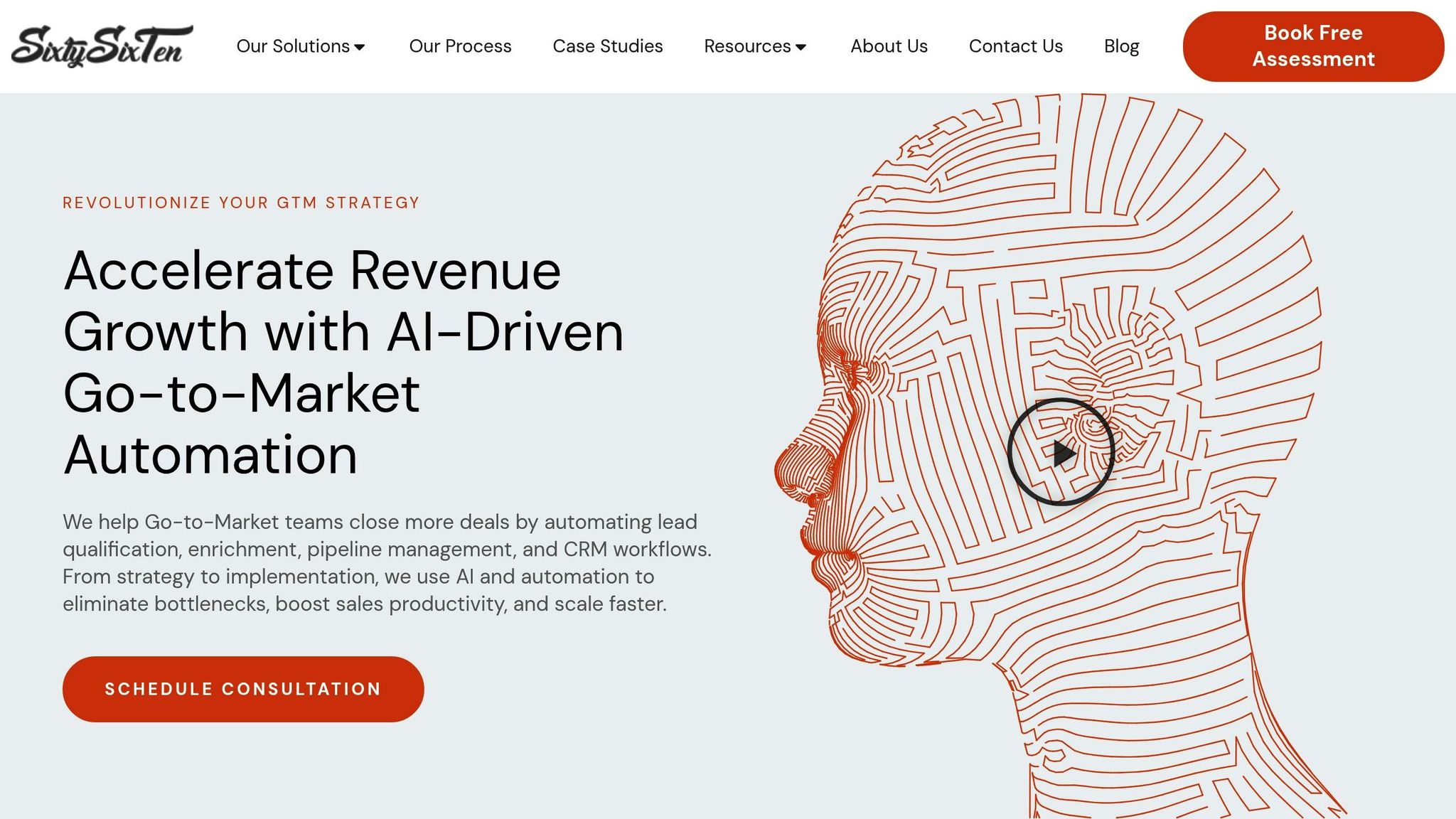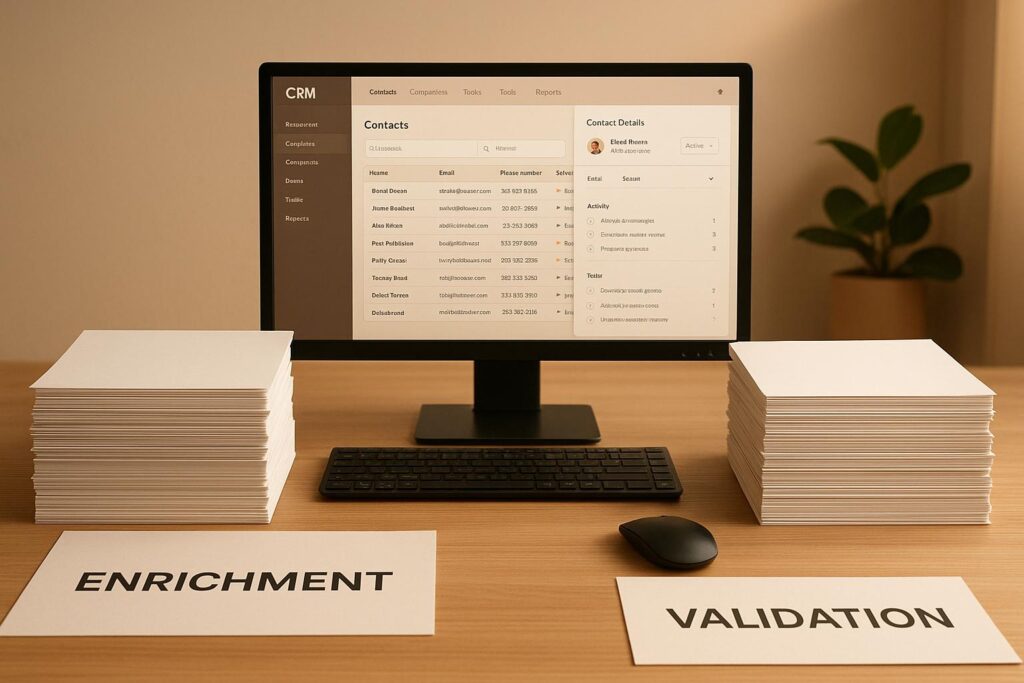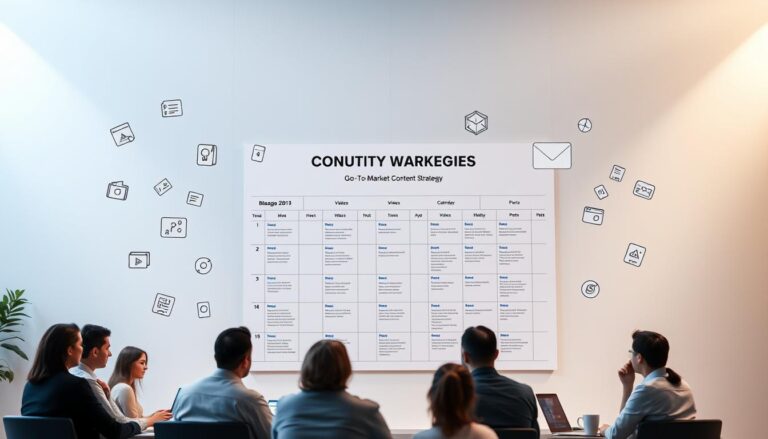Want to improve your sales and marketing efforts? Start by fixing your data. Poor-quality data leads to wasted time, failed outreach, and missed opportunities. Two key processes – data enrichment and data validation – can help. While often confused, they serve very different purposes:
- Data Enrichment: Adds missing details like job titles, company size, or social profiles to your records.
- Data Validation: Ensures the information you already have is accurate and reliable.
Which one should you use? It depends on your goals. Use validation to clean and verify data before outreach, and enrichment to add depth for personalized campaigns. Combining both ensures your data is accurate, complete, and ready to drive results.
Quick Comparison
| Aspect | Data Enrichment | Data Validation |
|---|---|---|
| Purpose | Add missing details | Verify existing data |
| Use Cases | Personalization, ABM | Email deliverability, data cleanup |
| Timing | Before targeted campaigns | Before outreach or major updates |
| Tools | Apollo, ZoomInfo, Clearbit | Email verification APIs, deduplication |
| Impact | Deeper insights for better targeting | Accurate data for reliable outreach |
Start by validating your data to remove errors, then enrich it to enhance personalization. Together, these processes ensure your sales and marketing teams work smarter, not harder.
Enrich – Update your records with Firmographic Enrichment, Contact Enrichment, and Email Validation
Prospect Data Enrichment: Adding Details to Your Data
Data enrichment takes basic contact details and transforms them into actionable insights for sales teams. While your CRM might start with just a name and email address, enrichment adds layers of valuable information, helping you better understand prospects, their needs, and the best ways to connect with them.
What Is Data Enrichment?
At its core, data enrichment means enhancing your existing contact records with additional information from external sources. This can include:
- Firmographics: Details like company size, industry, and revenue.
- Technographics: Insights into the technology and software a company uses.
- Demographics: Information such as job titles and seniority levels.
- Psychographics: Behavioral patterns and interests.
For example, starting with just a name and email, enrichment can add data like job title, company revenue, and industry classification. Suddenly, that basic record becomes a powerful sales resource, complete with the context needed to tailor your outreach.
The process involves cross-referencing your data with external databases, public records, social media profiles, and other business intelligence tools. Advanced systems can append dozens of data points to a single contact, giving you a well-rounded view of your potential customers.
Next, let’s look at the tools and techniques that make this process seamless.
Methods and Tools for Enrichment
Modern enrichment relies heavily on automation. Platforms like ZoomInfo, Apollo, and Clearbit offer APIs that pull data from their vast databases, while public sources like social media and company websites provide further context through automated scraping and profile analysis.
Automation tools such as n8n, Zapier, Make.com, and Clay.com simplify the process with customizable workflows. For instance, when a new lead enters your system, an automated workflow can:
- Fetch company details from a business database.
- Verify the prospect’s job title via LinkedIn.
- Analyze the company’s tech stack using a technographic service.
- Update your CRM with all the new information – often within minutes.
AI is also stepping into the data enrichment space. Machine learning algorithms can predict missing details, like estimating a company’s size or identifying buying signals, even when direct data isn’t available. These tools add another layer of precision and utility to the enrichment process.
With these automated methods, enrichment becomes faster and more efficient, delivering key advantages for sales and marketing teams.
Benefits of Data Enrichment
Enriched data doesn’t just make your records look better – it drives real results. Here’s how:
- Personalized Outreach: With enriched profiles, you can craft messages that resonate with your prospects. Research shows that 71% of buyers expect personalized interactions, and 76% get frustrated when outreach feels generic.
- Better Lead Scoring: Enriched data improves how you qualify leads. By incorporating factors like company size, industry, and recent business events, scoring models can better predict which prospects are most likely to convert.
- Increased Productivity: Sales reps spend less time researching and more time selling. When CRMs are automatically updated with relevant details, teams can focus on building relationships instead of hunting for information.
- Stronger Account-Based Marketing (ABM): Comprehensive profiles make it easier to identify high-value accounts and develop targeted engagement strategies.
The financial impact is hard to ignore. Poor-quality data costs businesses around $15 million annually in lost revenue. By integrating enriched profiles into your go-to-market workflows, you can launch highly targeted campaigns that drive revenue and improve efficiency.
In short, enriched data gives your team the tools to act faster, connect smarter, and close deals more effectively – all while staying ahead of the competition.
Prospect Data Validation: Checking Data Accuracy
While enrichment adds depth to your prospect records, validation ensures the information you rely on is accurate. Think of validation as your database’s quality control – it catches errors, eliminates duplicates, and confirms that your contact details are correct before you commit time and resources to outreach.
What Is Data Validation?
Data validation is the process of systematically checking your prospect data for accuracy, completeness, and consistency. Unlike enrichment, which adds new information, validation focuses on verifying the data you already have.
It also includes checking for outdated details. For instance, if a contact’s LinkedIn profile shows they switched companies six months ago but your CRM still lists their old employer, validation flags this mismatch for review or automatic correction.
The ultimate goal? A clean, reliable database that supports effective outreach and accurate reporting. When your data is validated, you can trust it to guide smart business decisions and productive sales conversations.
Common Validation Techniques
Modern data validation blends automated checks with real-time verification services to ensure accuracy. Here are some key techniques:
- Email verification: This process uses tools that ping email servers to confirm if an address is active and deliverable – without actually sending an email. This helps prevent high bounce rates, which can harm your sender reputation.
- Syntax validation: These checks catch formatting errors, ensuring that phone numbers, email addresses, and postal codes follow proper patterns. For example, email addresses must include elements like "@" and domain extensions, while phone numbers need to match expected formats.
- Deduplication: Advanced algorithms identify and merge duplicate records by comparing multiple fields such as names, email addresses, and company domains. For instance, it might detect that "John Smith at ABC Corp" and "J. Smith at ABC Corporation" are the same person, even if the details aren’t an exact match.
- Real-time updates: These systems connect to external sources to verify current employment status, company details, and contact information. If someone updates their LinkedIn profile or a company announces a merger, your records can be flagged for review.
- Compliance validation: This ensures your data collection and storage practices align with regulations. It checks for consent records, monitors data retention periods, and flags contacts who have opted out of communications.
Automation platforms like n8n, Zapier, and Make.com can integrate these techniques into workflows that run continuously in the background. This keeps your data accurate without requiring constant manual effort.
Benefits of Data Validation
Validated data isn’t just about avoiding mistakes – it delivers real, measurable benefits across your operations:
- Improved email deliverability: Removing invalid email addresses significantly reduces bounce rates, protecting your sender reputation and ensuring your messages reach the right inboxes.
- Cleaner CRM systems: A well-maintained database saves your sales team time. Instead of wading through duplicates or chasing outdated leads, they can focus on engaging with qualified prospects. Clean data also means more accurate reporting, giving leadership a clear view of performance metrics.
- Cost savings: By eliminating bad data, you avoid wasting ad spend on unreachable prospects or sending mail to outdated addresses. Every penny saved here can be reinvested where it matters most.
- Compliance assurance: With regulations like the California Consumer Privacy Act (CCPA), maintaining accurate records is critical. Validated data ensures you can handle privacy requests accurately and demonstrate compliance during audits.
- Better customer interactions: Outdated or incorrect information can damage your credibility. Addressing someone by an old job title or referencing a company they left months ago reflects poorly on your team. Validated data helps you come across as professional and knowledgeable in every interaction.
- Stronger financial outcomes: Clean, accurate data leads to higher response rates, shorter sales cycles, and improved customer satisfaction. Together, these factors drive revenue growth and give your business a competitive edge.
sbb-itb-647c22e
Key Differences Between Data Enrichment and Validation
Data enrichment and validation serve distinct purposes in managing prospect information. While enrichment enhances profiles by adding new details, validation ensures the data you already have is accurate. The table below highlights these differences.
Enrichment vs. Validation: A Comparison Table
| Aspect | Data Enrichment | Data Validation |
|---|---|---|
| Primary Purpose | Fill in missing details for prospect records | Verify the accuracy of existing information |
| Data Flow | Adds new data from external sources | Confirms and corrects data already in your system |
| Common Use Cases | Adding email addresses, job titles, revenue figures, or social profiles | Verifying email deliverability, removing duplicates, and updating outdated records |
| Timing | Ideal before launching outreach campaigns | Ongoing process, especially before large-scale efforts |
| Cost Impact | Requires investment in external data and tools | Reduces wasted resources by improving outreach accuracy |
| Success Metrics | More complete profiles and additional fields populated | Improved data accuracy, fewer bounces, and duplicate-free records |
| Automation Tools | Tools like Clay.com, Apollo, and ZoomInfo | Email verification APIs and deduplication software |
| Risk Factor | Potential inaccuracies from unreliable external data | Minimal risk, as it focuses on refining existing data |
When to Use Each Process
Knowing when to apply enrichment or validation can make a big difference in your data management strategy.
Use enrichment when expanding into new markets or implementing account-based marketing (ABM). For example, if your CRM only contains basic contact information, enrichment can add details like job titles, phone numbers, company size, or funding data – helping personalize outreach efforts.
Use validation before launching high-volume campaigns or when you notice a drop in engagement metrics. It’s also essential during CRM migrations, periodic data cleanups, or compliance checks. Validation ensures your database remains accurate and reliable, preventing revenue loss due to bad data.
A smart approach is to validate your data first and then enrich it. This sequence avoids wasting resources on enriching records with fundamental errors, ensuring both accuracy and depth in your database.
When deciding which process to prioritize, consider your sales team’s immediate challenges. If they’re struggling to connect with prospects, validation can address issues like undeliverable emails. If outreach lacks personalization, enrichment can provide the extra details needed for meaningful conversations. By aligning these processes with your goals, you can improve go-to-market efficiency and ensure every contact is both reliable and insightful.
Combining Enrichment and Validation in GTM Automation
Bringing together enrichment and validation ensures your data is accurate, complete, and ready for action – all without the hassle of manual intervention.
Best Practices for Sequencing
Start by validating your data. This means tackling tasks like removing duplicates, verifying email deliverability, and checking for active company domains. Once your data passes these initial checks, you can enrich it with valuable details like job titles, revenue figures, and social media profiles. Regularly schedule these validations and set up workflows to handle failed records, such as invalid emails, so they can be addressed efficiently.
With a clear sequencing strategy in place, advanced automation tools can seamlessly connect these steps, making the process smoother and more efficient.
Automation Tools and Benefits
Platforms like n8n and Zapier are game-changers for creating custom workflows. These tools can validate CRM entries first and then enrich them with company data and signals. SixtySixTen takes this a step further by combining no-code/low-code solutions with custom-coded tools, incorporating AI-driven scoring to manage complex rules and tap into proprietary data sources.
By prioritizing validation before enrichment, automated workflows enhance data quality while reducing wasted resources. Beyond saving time, automation cuts down on errors and provides an audit trail – helpful for staying compliant.
Operational Impact of Integrated Workflows
The operational advantages of these automated workflows are hard to ignore. For one, they free up sales teams from tedious data-cleaning tasks, allowing them to focus on engaging with prospects. At the same time, marketing teams benefit from complete and accurate data, which drives better campaign performance and shorter sales cycles.
Take email campaigns, for example. Validated email addresses combined with enriched personalization data can significantly improve engagement rates. This leads to more qualified meetings and faster sales cycles. Clean CRM data also enhances reporting and forecasting, empowering revenue operations teams to make smarter decisions about resource allocation and market strategy.
Another perk? Integrated workflows allow you to focus enrichment efforts on your most promising leads, keeping data costs in check while maintaining quality. Over time, these improvements enable quicker responses to market opportunities, more scalable outreach, and greater efficiency – all of which contribute to driving revenue growth.
Conclusion: Choosing the Right Approach for Your GTM Strategy
As we’ve discussed, data enrichment and validation work hand in hand to strengthen your go-to-market (GTM) efforts. Validation ensures your data is accurate and reliable, while enrichment provides the extra context and insights needed to tailor outreach and prioritize prospects with precision.
Together, these processes form the backbone of a more effective and efficient GTM strategy.
Key Takeaways
- Validate before you enrich. Always start by cleaning and verifying your data. Enriching inaccurate data wastes time and resources. Clean, verified contact information lays the groundwork for meaningful engagement, while enriched data empowers personalized and impactful outreach.
- Automation saves time and boosts impact. Manual data cleaning can be a major time sink. Automated workflows handle validation, enrichment, and real-time updates, freeing your team to focus on driving revenue instead of wrestling with spreadsheets.
- Quality beats quantity. A smaller, well-validated database will always outperform a massive list of unverified contacts. Clean data enhances email deliverability, reduces bounce rates, and helps your outreach resonate with the right audience.
- Integration is key. Combining validation and enrichment within your CRM or marketing automation tools creates a continuous cycle of data improvement. This integration helps with lead scoring, more accurate forecasting, and faster identification of high-value opportunities.
How SixtySixTen Can Help

SixtySixTen specializes in building GTM automation systems that merge data validation and enrichment seamlessly. Using platforms like n8n, Clay.com, and Zapier, along with custom-coded solutions, we design workflows that handle:
- Automatic validation of new leads entering your CRM.
- Enrichment of qualified prospects with relevant company and contact details.
- Ongoing monitoring to maintain data quality over time.
Our AI-driven solutions can manage lead scoring, access proprietary data sources, and adapt to the needs of your market. For post-PMF B2B SaaS companies, we create real-time dashboards that clearly show how improved data quality translates into better conversion rates and shorter sales cycles.
We start with a free assessment of your current data processes, then offer tailored implementation and ongoing support to ensure your systems evolve with your business. Whether you’re looking for simple tool integrations or fully custom solutions, SixtySixTen turns manual data tasks into scalable systems that drive growth.
FAQs
What’s the difference between data enrichment and validation, and how do they improve sales and marketing efforts?
Data enrichment and validation work hand in hand to boost the quality and effectiveness of your sales and marketing data. Data enrichment involves adding useful details to your existing data, such as industry type, job roles, or company size. This extra layer of information allows for more precise and personalized outreach efforts. Meanwhile, data validation focuses on ensuring your data is accurate, current, and error-free, minimizing the chances of acting on outdated or incorrect information.
Together, these processes lay a solid groundwork for successful sales and marketing initiatives. Enriched data helps teams focus on high-priority leads and craft tailored messages, while validated data ensures consistency and dependability across both sales and marketing efforts. This synergy results in stronger customer connections, sharper targeting, and, ultimately, higher revenue.
What are the best practices for automating data enrichment and validation?
To make data enrichment and validation more efficient, start by using AI and machine learning. These tools can simplify the process by identifying missing information, cleaning up inconsistencies, and adding relevant details to your data – all with minimal manual input.
It’s also important to set up strong validation checks from the beginning. This helps protect data quality and minimizes errors. Keep an eye on how your automation tools are performing, making adjustments as needed to ensure they consistently deliver accurate and dependable results. On top of that, create a routine for regular data reviews to ensure your processes stay in sync with evolving business goals and your go-to-market (GTM) strategy.
By thoughtfully automating these steps, you can cut down on manual tasks, boost efficiency, and keep your data in top shape to support your GTM efforts.
What impact do data enrichment and validation have on email deliverability and lead conversion rates?
Data enrichment plays a crucial role in improving email deliverability and boosting lead conversion rates. By building more detailed and accurate contact profiles, it enables you to prioritize high-quality leads, lower bounce rates, and sharpen the focus of your campaign targeting.
When your data is validated, key details like email addresses are confirmed to be accurate and current. This reduces problems like undeliverable emails or unreliable metrics. Combined, these strategies enhance engagement, simplify outreach efforts, and deliver stronger results across your go-to-market workflows.



